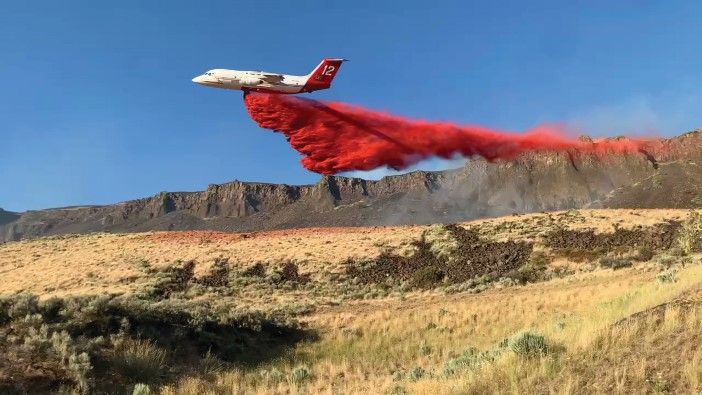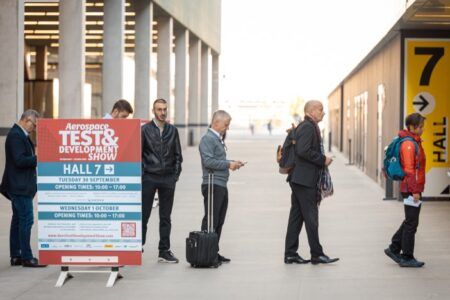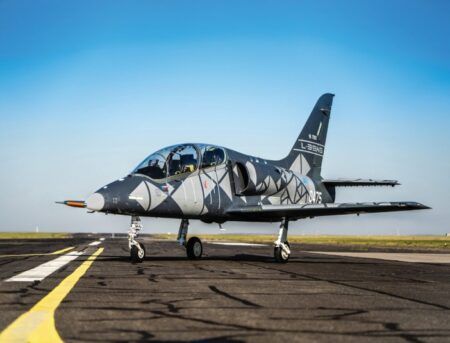Two days into the wildfires that devastated huge swathes of Los Angeles earlier this year, Neptune Aviation got the call to deploy. The Montana-based aviation company, which has been fighting wildfires in the USA since the early 1990s, immediately sent one of its fleet of nine air tankers to California.
“We had three planes already on station in Southern California when the fire started, and then we deployed the fourth one,” says Nicholas Lynn, Neptune’s vice president of operations. “We typically respond in less than 24 hours.
“Each aircraft typically deploys with four crew, a captain, a first officer, a crew chief who rides on board the airplane during repositioning flights, and a mechanic who drives a support van with parts and tools.”
The Los Angeles wildfires broke out in January and ran for three weeks, killing at least 30 people, destroying more than 18,000 homes and structures, and burning over 57,000 acres. During the ongoing battle to contain the blaze, Neptune ran its aerial fire-fighting operation from two air tanker bases in San Bernardino and Lancaster, California, says Lynn.
STRATEGIC BASE NETWORK
Across the USA there are more than 40 such bases, which are designed to accommodate the air tankers used in firefighting and fitted with the equipment to mix and pump into planes the retardant used to fight the fire.

“The fire seasons are getting longer and more intense” NICHOLAS LYNN, VICE PRESIDENT OF OPERATIONS, NEPTUNE AVIATION
“Those bases are strategically spread out throughout the country,” he says. According to Lynn, the bases are operated by a mix of federal and state agencies including the US Forest Service, and the Bureau of Land Management.
For the duration of the fire season Neptune’s planes are under contract to one of these agencies.
“We have what we call a mandatory availability period – a contract we have with the agency with a start date and a projected end date. So once those airplanes deploy, especially the ones that are under federal contract, they become what’s called a ‘national asset’.
“The airplane doesn’t have a home base; we don’t know where it’s going to be day-to-day. They move wherever the activity is.”
In an era of climate change the length of those deployments is increasing. Lynn says, “The fire seasons are certainly getting longer and more intense. Back in the late 1990s and early 2000s, we’d average around 150 hours of flight time on an airplane each season. Now we’re closer to 300 hours on each airplane. This past year we had three airplanes that stayed out continuously until they were due for maintenance.”
EUROPEAN FIRES
The same story holds true in Europe, says David Pincet, the former head of the French Ministry of Interior’s aerial firefighting fleet.

“Ten years ago 90% of the fires were located around the Mediterranean Sea,” says Pincet. “Whereas today no area is really protected. In 2021, for example, we had more surface burn in the region of Brittany than in the southeast of France.”
While the implications of this might look bleak, it does mean that the demand for aerial firefighting craft has never been higher. Responding to this demand, Pincet left his government posting to start Hynaero, a Bordeaux-based company developing a new amphibious aircraft for firefighting duties around the world.
CHALLENGES
According to Pincet, “the future will be a challenge” if no new amphibious aircraft is developed for firefighting. At present, the market is dominated by the Canadair CL-415, the Super Scooper, and its earlier iteration, the CL-215.
Hynaero plans to challenge this dominance with the FREGATE-F100, an amphibious water bomber with a payload capacity of 10 tons of water, a cruising speed of 250 knots and a potential mission time of more than three hours at 120 nautical miles (220km) from its base location. During the Paris Air Show, the French Government gave a €7 million grant to the company.
While the aircraft only exists for now as a validated 3D concept, Pincet’s confidence in his creation seems to be shared by Airbus, who recently partnered with the French startup to help them develop the new aircraft.

“Until now we have done it by ourselves,” says Pincet. “Now Airbus has decided to join in support of our program. Since we are not an established aerospace company, we don’t have the time to build the expertise as an aircraft designer and producer. So we need the support of industry partners who know how to do business. Otherwise, it will take too much time and cost too much.”
According to Pincet, the FREGATE-F100 was singled out by Airbus because it is a “realistic approach” that “answers the demands of the market.” Hynaero’s design team arrived at the plane’s design through talking to firefighting crews, asking them to “define operational specifications for the aircraft,” says Pincet.
“We’re closer to 300 hours on each airplane compared to 150 hours in the early 2000s” NICHOLAS LYNN, VICE PRESIDENT OF OPERATIONS, NEPTUNE AVIATION
ROBUST REQUIREMENTS
For an aircraft to be used in firefighting it needs to have an airframe that is robust enough to withstand the wind shear resulting from the heat given off by wildfires as it flies over them, he says. Since the FREGATE-F100 is an amphibious craft, the airframe also has to be able to withstand the effects of pummeling by waves as it flies over bodies of water to collect its payload.
During these scooping sessions the airframe can be damaged by debris such as driftwood. For this reason, says Pincet, the hull must be metal rather than composite, since metal is easier to repair.
While the FREGATE-F100 is designed to fight fire with water, Neptune’s fleet of nine BAe 146s use retardant to tackle blazes. According to Lynn, the BAe 146 is capable of carrying 3,000 gallons retardant and have “excellent maneuverability, great slow speed characteristics, and overall is a fantastic platform.”
However, he says “the 146 has been out of production for a long time, so parts and support are getting thinner.”
He adds: “It’s still very maintainable and we anticipate operating the airplane for another 10 years, but it takes a number of years to identify, convert and certify a new platform so it’s time to get that ball rolling on our end.”
After a lengthy search Neptune have identified a successor to its fleet of 146s, settling on the Airbus 319.

“We’re really excited about its capabilities,” says Lynn. “The airplane will be able to carry 4,500 gallons of retardant versus the 3,000 that the 146 carries.
“It’ll be able to operate out of all the tanker bases that are already established throughout the country and it’ll be able to go higher and faster so we can reposition and get to things quicker.”
“Ten years ago 90% of the fires were located around the Mediterranean, today no area is really protected” DAVID PINCET, FOUNDER, HYNAERO
DRONE INTEGRATION
Fighting wildfires aerially is not just the domain of manned aircraft. In recent years, several fire agencies have been looking to integrate drones into their firefighting operations.
Drones have a number of potential uses when it comes to battling large-scale blazes, says Min Xue, project manager of the Advanced Capabilities for Emergency Response Operations (ACERO) project at NASA’s Aeronautics Research Mission Directorate.

“There are many different type of applications starting from information collection,” says Xue. At present most wildfire operations rely on satellite data to get a visual overview of the fire. But satellites overfly wildfire zones infrequently and can provide only a limited resolution of the affected area.
With drones, by comparison, “you can have very fine resolution real-time data,” says Xue.

They can also provide real-time data on turbulence and wind speed, giving firefighters up to the minute information on how the fire is developing.
Drones can also be used for logistics support, providing vital supplies to the on-the-ground firefighters such as water, battery units, and protective fire shelters. Another potential use is as an aerial cell tower, providing local network connectivity to the area of operations, he says.

But perhaps the biggest potential benefit of incorporating drones into wildfire management is their ability to fly at any time of the day or night. Since aerial firefighting operations require pilots to be able to physically see the fire, it is only currently possible to deploy firefighting aircraft during daylight hours and when visibility is good.
Once visibility is compromised by climatic or other factors, and when night falls, pilots have to return to base. To solve this limitation, Xue and his fellow researchers on the ACERO project have been developing a portable airspace management system (PAMS) that could be used to monitor and control 24-hour drone operations for wildfire response.
TESTING AIRSPACE MANAGEMENT
So far the PAMS system has been tested at various locations across the US, including most recently this March in Salinas, California, where it coordinated the flight operations of two small drones, an electric vertical takeoff and landing aircraft, and a remotely piloted aircraft with a backup pilot aboard.
The drones and aircraft demonstrated examples of critical tasks for wildland fire management, including weather data sharing, simulated aerial ignition flights, and communications relay. Xue hopes the PAMS system will eventually be handed over to wildland fire crews for use in the field, helping to protect communities and wildlife from the growing menace posed by wildfires.
Xue thinks the system could find its way into full-scale deployment via “a tech transfer to a fire agency or even to industry partners, who can quickly develop the system based on the specifications we developed.”
THE TACTICS USED TO FIGHT WILDFIRES FROM THE AIR
There are two main ways aircraft are used to fight wildfires, either by dropping retardant on the blaze or by fighting it with water. According to David Pincet of Hynaero, these two methods are integral to getting a wildfire under control. But understanding which tactic to use and when requires understanding how wildfires form and advance.
“The idea is that a fire always progresses in a V-shape,” says Pincet. The side of the fire that is advancing is more critical to get under control because “it is progressing towards an area that you want to protect, installations and infrastructure for example. So you concentrate your firefighting capacities on this front,” he says.
The slowing down of the forward advance of the fire is done by dumping water on it with amphibious water-scooping vessels like the Canadair class of fire-fighting planes, which can replenish their payload more easily than tanker jets like those operated by Neptune Aviation, which need to land in order to take on board more retardant.
According to Pincet, the retardant – which is made from a mix of water and fertilizer – is generally dumped on the other side of the blaze. Understanding how much retardant to drop requires a knowledge of coverage levels of different types of terrain, says Neptune Aviation’s Nicholas Lynn.
“It takes a lot less retardant to cover a field of grass than it does to cover tall pine trees,” says Lynn.
“The pilots will select how much retardant they want to drop and the coverage level, and then an onboard computer will control the flow of the retardant out of the airplane to achieve those specifics,” says Lynn.
HOW TO TRAIN A FIREFIGHTING PILOT
Learning how to pilot a plane to fight wildfires is a highly specialized, technically difficult job that takes years to master and can be broken down into three phases, says Neptune Aviation’s Nicholas Lynn.
“First we have to teach them [the pilot] how to fly the airplane, which includes getting certified, and honestly that’s probably the easiest thing we do,” says Lynn. Once they have mastered how to fly the plane, they need to be taught how to operate it in a firefighting scenario, he says.
“They have to understand fuels and terrain, weather and tactics and all the things that go into fighting a fire” Lynn says. “Then we have to teach them how to merge those two skillsets and fly the airplane low level – we typically target a 150ft drop height – at drop speeds of around 125-135 knots, depending on the weight of the airplane.
“Then we teach them how to fight fire with the airplane in that environment – and it takes quite a bit of time, typically about four years to move somebody from first officer to what’s called an initial attack captain.”
According to Lynn, the initial attack captain rating means that the pilot is trained to “respond to a fire without any other resources, and assess it and begin to fight it without any other support.”
AUTONOMOUS CARGO DRONES FLIGHT TESTED FOR FIREFIGHTING
Last year, the Lancashire Fire and Rescue Service in the UK partnered with cargo drone developer WIndracers and AI and robotics researchers from Bristol and Sheffield Universities to flight test a swarm of self-coordinating autonomous drones for firefighting.
The week-long trial based at Preddanack Airport in Cornwall tested the autonomous fire detection and swarm capabilities using one ULTRA and three smaller drones. The Windracer ULTRA self-flying cargo aircraft, which have also been used to carry parcels to the Orkney Islands and collect scientific data in Antarctica, are able to carry 100kg (220lb) of fire retardant.
According to the company, the drones can fly autonomously to monitor danger areas over the summer months, with a swarm of drones potentially covering areas the size of Greece. ULTRA and the drones identified and approached a number of small, controlled fires. The partners described the test as a key milestone.





